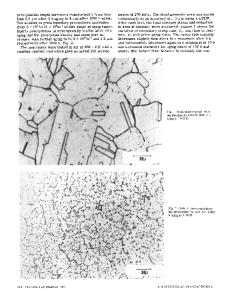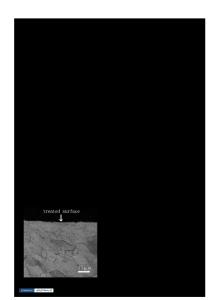The Effect of Duplex Processing on the Mechanical Properties of Grade 316L Stainless Steel
- PDF / 712,285 Bytes
- 4 Pages / 612 x 792 pts (letter) Page_size
- 1 Downloads / 340 Views
fect of Duplex Processing on the Mechanical Properties of Grade 316L Stainless Steel A. S. Grenadyorova*, A. A. Solovyeva, and K. V. Oskomova a
Institute of High Current Electronics, Siberian Branch, Russian Academy of Sciences, Tomsk, 634055 Russia *e-mail: [email protected] Received July 3, 2020; revised July 3, 2020; accepted July 24, 2020
Abstract—We present the results of experimental studies of the modification of the surface layer of grade 316L steel by duplex treatment, including ion-plasma treatment under nitrogen followed by plasma activated chemical vapor deposition of hydrocarbon films doped with silicon and oxygen (a-C:H:SiOx). The mechanical properties of the steel surface (hardness, modulus of elasticity, plasticity index, resistance to plastic deformation) were determined by the nanoindentation method, and the adhesion of the films was evaluated by the scratch test method. The greatest improvement in the mechanical properties of the film–substrate system was observed after the deposition of an a-C:H:SiOx film on a surface preliminarily hardened by ion-plasma treatment in a nitrogen plasma. Keywords: plasma treatment, diamond-like carbon, a-C:H:SiOx films, hardness, adhesion. DOI: 10.1134/S106378502011005X
Metallic materials (stainless steel, titanium- and cobalt-based alloys, etc.) are used to create more than 60% of medical implants [1]. This is due to their high strength characteristics, such as yield strength and fatigue strength (compared to ceramics and polymers). However, their constituent chemical elements (Al, V, Ni, Co, Cr) cause toxic and allergic reactions in the body. The low wear resistance of these materials also leads to the formation of metal fragments at the points of contact of the rubbing parts of the artificial joint. To solve these problems, biocompatible and wear-resistant coatings are applied to the surface of a metal material [2]. Diamond-like carbon (DLC) films with high hardness (up to 50–70 GPa), wear resistance, and biocompatibility are excellent for this purpose [2, 3]. The disadvantage of DLC films is their high internal stress (up to 7 GPa), which decreases the adhesion of the coatings and shortens their service life [4]. Silicon- and oxygen-doped hydrocarbon films (a-C:H:SiOx) are a type of diamond-like carbon. It is an amorphous material consisting of interpenetrating a-C:H and a-Si:O matrices. This material has low internal stress (≤1 GPa), high hardness up to 20 GPa [5, 6], low wear rates (~10–7 mm3/N m) and the coefficient of friction (~0.15) [7], and high compatibility with the human biological environment [8]. A disadvantage of hard and superhard coatings applied to relatively “soft” substrates is their high fragility. It manifests itself with significant deformation of the base during operation. To solve this problem,
the surface is preliminarily hardened by its diffusion saturation with carbon or nitrogen. Boromei et al. [9] showed that after AISI 316L carburizing stainless steel, the hardness of its surface increased more than three times. This increased th
Data Loading...











